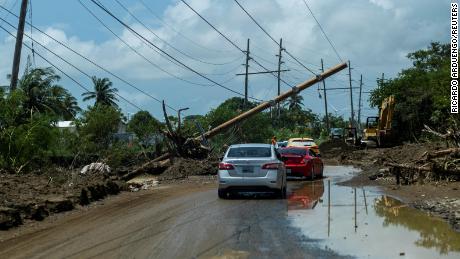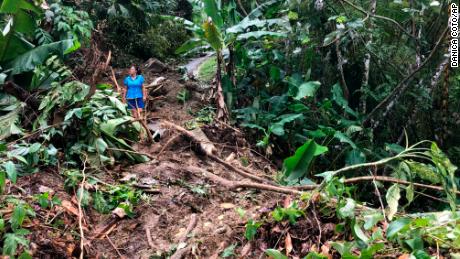It’s on track to be an “extreme weather event” in eastern Canada, threatening strong winds, dangerous storm surge and about two months of rain, Canadian Hurricane Center forecasters warned Friday after- midday. And some regions, like the Canadian Maritimes, will likely start to feel the effects on Friday night, the center said.
“This could be a landmark event for Canada in terms of tropical cyclone intensity,” and it could even become Canada’s version of Super Hurricane Sandy, said Chris Fogarty, director of the Canadian Hurricane Center. Hurricane Sandy affected 24 states and the entire east coast, causing damage estimated at $78.7 billion.
Officials in Nova Scotia and Prince Edward Island in Canada urged those in the storm’s path to be on high alert and prepare for the impact of the storm. hurricane, which has already claimed the lives of at least five people and knocked out power to millions this week as it battered several Caribbean islands.
Fiona upgraded to a Category 4 storm early Wednesday over the Atlantic after passing the Turks and Caicos Islands, and remained so until Friday afternoon.
The National Hurricane Center said in a 5 p.m. ET advisory that the storm weakened slightly, but still whipped up powerful hurricane-force winds extending more than 100 miles from its center and even stronger gusts. Its center was about 370 miles south-southeast of Halifax.
Hurricane warning for parts of Nova Scotia
In Canada, hurricane warnings were in place for Nova Scotia from Hubbards to Brule and Newfoundland from Parson’s Pond to Francois. Prince Edward Island and Île-de-la-Madeleine are also subject to warnings.
Residents should prepare for damaging winds, high waves, coastal storm surges and heavy rains, which can lead to prolonged power outages, Lohr said. Emergency officials encouraged people to secure outdoor items, trim trees, charge cellphones and create a 72-hour emergency kit.
The region hasn’t seen such an intense storm in about 50 years, according to Chris Fogarty, director of the Canadian Hurricane Centre.
“Please take it seriously as we see weather numbers on our weather maps that are rarely seen here,” Fogarty said.
Utility company Nova Scotia Power activated an emergency operations center (EOC) on Friday morning that will serve as a central coordination area for restoration and outage response, according to a news release.
The company will also work closely with the Nova Scotia Emergency Management Office.
“We are taking every precaution and will be prepared to respond to Hurricane Fiona in the safest and most efficient manner possible,” Sean Borden, senior storm coordinator for Nova Scotia Power, said in the statement.
Andy Francis, a fisherman from southwest Newfoundland, was bracing for the storm this week, pulling one boat out of the water and tying another to a nearby dock.
“It will be different,” Francis told CBC.
Across Atlantic Canada, winds could be around 100 mph (160 km/h) as Fiona is expected to weaken a bit before making landfall in Nova Scotia, CNN meteorologists Rob Shackelford and Taylor Ward said. .
Prince Edward Island officials have implored residents to prepare for the worst as the storm looms.
Tanya Mullally, who serves as the province’s chief emergency officer, said one of the most pressing concerns with Fiona is the historic storm surge it is expected to unleash.
Modeling from the Canadian Hurricane Center suggests the surge “depending on the area, could be 1.8 to 2.4 meters (6 to 8 feet),” said Bob Robichaud, a meteorologist at the center.
The northern part of the island is expected to bear the brunt of the storm due to the direction of the winds, which will likely cause property damage and coastal flooding, Mullally said.
All provincial campgrounds, beaches and day-use parks as well as the Shubenacadie Wildlife Park closed on Friday, the Nova Scotia Emergency Management Office said.
Fiona’s blackouts continue
Earlier this week, Fiona damaged homes and disrupted critical power and water infrastructure for millions of people in Puerto Rico, the Dominican Republic and the Turks and Caicos Islands.
The massive power outage comes as much of Puerto Rico experiences extreme heat, which sent temperatures soaring as high as 112 degrees Thursday, according to the National Weather Service. Temperatures remained in the 80s and 90s on Friday, according to CNN meteorologist Taylor Ward.
Daniel Hernández, director of renewable projects at LUMA, explained that critical locations, including hospitals, will be prioritized before repairs can begin at the individual level.
“It’s a normal process. The important thing is for everyone to be calm…we’re working to get 100% of customers served as soon as possible,” Hernández said.
And more than a quarter of customers on the island had no water service or had intermittent service, according to the emergency portal system.
In the Dominican Republic, Fiona has reached over 8.00 households and destroyed 2,262 homes, according to the country’s emergency operations chief, Major General Juan Méndez García.
He said more than 210,000 homes and businesses were still in the dark on Thursday morning and another 725,246 customers were without running water.
“It was something incredible that we had never seen before,” Ramona Santana in Higüey, Dominican Republic, told CNN en Español this week. “We’re on the streets with nothing, no food, no shoes, no clothes, just what’s on your back. … We have nothing. We have God, and hope that help will come. “
Fiona also threatened parts of the Turks and Caicos Islands on Tuesday, and areas of British territory were still without power earlier this week, including Grand Turk, South Caicos, Salt Cay, North Caicos and Middle Caicos, Anya Williams said. acting governor of the islands.
CNN’s Allison Chinchar, Melissa Alonso, Ana Melgar Zuniga and Amanda Musa contributed to this report.


